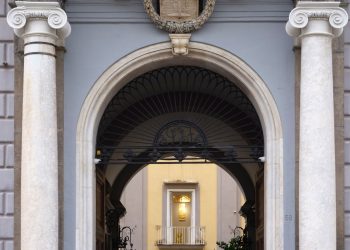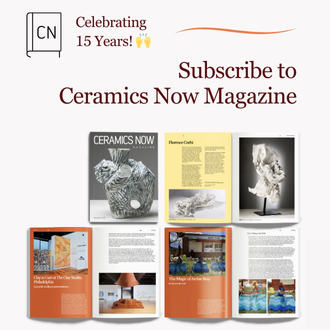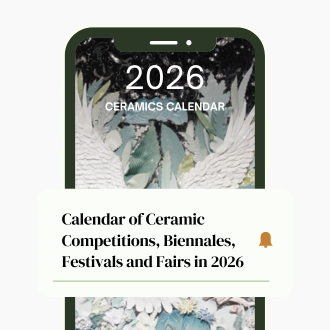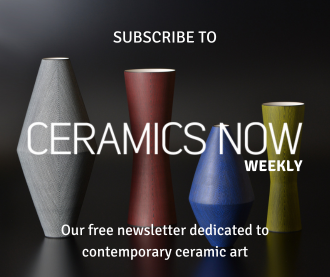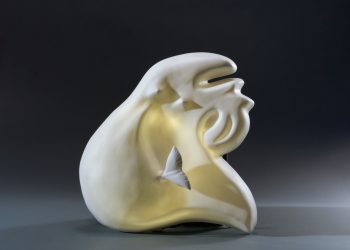By Katherina Perlongo
For one weekend in June, a former drugstore tucked inside a shopping mall in Berlin’s Wedding district was transformed into a vibrant showcase of contemporary ceramic art. The works of 23 artists filled the space, offering a rare and compelling glimpse into Berlin’s quietly thriving but often overlooked ceramics scene.
Formed marked the first public expression of a growing, self-organized network of ceramic artists who, over the past two years, have fostered a strong sense of community through the Ceramic Salon – a grassroots initiative born from a shared desire for dialogue, collaboration, and mutual support. The Salon was co-founded by Lisa Kosak (Helka Ceramics) and Marten Herma Anderson, who first met – or rather reconnected – at an art event, having long followed each other’s work on social media. They shared the feeling that while Berlin was home to many exciting ceramic practices, these voices rarely converged. Out of this realization, the Ceramic Salon was born: a platform not only for conversation and critique but also for exchanging technical knowledge and building a peer-led infrastructure in a field still lacking institutional support. Since then, the Salon has taken place monthly in various artists’ studios across the city. Each meeting typically begins with a focused question about a specific work and unfolds into hours of discussion, covering everything from glaze chemistry and kiln access to design dilemmas and drying techniques. In a community where many artists are self-taught, this culture of open exchange, rather than gatekeeping, has proven vital. Today, with around 15 regularly active participants and an ever-widening circle of contributors, the Ceramic Salon has grown into a dynamic force shaping Berlin’s ceramic landscape from the ground up – beyond traditional gallery systems, with its own language, logic, and visibility.
Formed represented more than the sum of its parts. It was the first curated presentation of works emerging from this collaborative framework, a testament to what can happen when knowledge, resources, and ideas are shared rather than siloed. The exhibition itself reflected the diversity of practices within the network: there was no singular aesthetic but rather a wide-ranging spectrum of approaches – from functional tableware and furniture to objects with architectural references, whimsical sculptures, and bold material experiments. The title of the show speaks to both the medium and the movement: to the infinite shapes clay can assume, but also to the shaping of an ongoing, growing network.







Despite the diversity and complexity of the positions represented in the exhibition, clear thematic threads emerged across individual works. In the practices of Marten Herma Anderson, Latika Nehra, and Studio Cúze, a shared concern becomes visible: how memory, biography, and cultural imprinting can be inscribed into ceramic form – each through distinctly different approaches. The spectrum ranges from emotionally charged evocations of personal history to speculative bodies and ritualized gestures of silence.
Marten Herma Anderson’s works occupy a space between sculptural assertion and biographical encoding. Their raw presence – reinforced by iridescent surfaces and allusions to architectural structures – lends them a quiet but undeniable authority in the room. These are objects that resist fixed classification: neither purely sculptural nor strictly functional. Their power lies in this very in-between state – between hard-edged structure and tender memory, brutalist vocabulary and intimate childhood moments, often mediated through botanical references. Flowers reoccur – drawn from memories of his grandmother’s garden on the Baltic island of Rügen, from wild poppies that must not be picked, or hollyhocks whose seeds the artist collected on a trip to Sweden and planted at home. Rather than relying on conventional glazes, he uses materials sourced from car tuning culture, like shimmering liquid plastics originally designed for alloy rims. These so-called flip-flop paints shift color depending on the angle of light, triggering memories of funfairs and bumper cars glinting under the lights: “I was fascinated by the idea that an object could have not just one color – but several, depending on where you stand.” His forms appear self-contained yet porous, as though they might store, preserve, or conceal something. Here, ceramic becomes a vessel for an affective archive – not documentary, but atmospheric.
Latika Nehra follows a markedly different formal language. Her work merges meticulous craftsmanship with speculative inquiry. Her objects appear as if excavated – artifacts from a distant past or an imagined future – at once familiar and strange. They recall bones, fossilized structures, or archaic tools, while simultaneously raising questions about the future of the body, transformation technologies, and the entanglement of the organic and artificial. Originally from India, Nehra spends extended periods there, and this deep connection is inscribed in the temporality of her process. Her entire practice is rooted in hand-making techniques – long hours of forming, tapping, grinding, and polishing surfaces until they appear almost petrified. These objects are typically left unglazed, treated instead in ways that evoke geological processes. Her smooth, pale surfaces feel skin-like, suggesting the body not only as a carrier of personal and collective history but also as a speculative terrain. Memory here is not linear or autobiographical; it embeds itself in organic form. The result is a series of objects that resist clear interpretation but open a resonant space where body, time, materiality – and the idea of mutation – intersect.
Studio Cúze pushes the abstraction of memory to its limits. Rather than drawing on personal biography or cultural reference, his work explores repetition, rhythm, and ritual. The ceramic forms are distilled to their essentials – modular, serial, and composed in subtle variations. Circles, arches, and U-shapes recur like quiet mantras, floating between vessel, sculpture, and symbol. These objects radiate a calm intensity; memory is not narrated but embodied through gesture, through the act of doing again. This restrained, almost meditative formal language reveals both conceptual discipline and an intuitive faith in material as a conduit for non-verbal knowledge. Within the exhibition’s theme Formed, Studio Cúze is among the few who approach the idea of form not only through substance but also as structure – as a grammar of making. His recurring shapes function like a visual vocabulary, reduced yet resonant, oscillating between objecthood and ritual. These works seem to speak inwardly: to emptiness as presence, to form as a container of meaning.







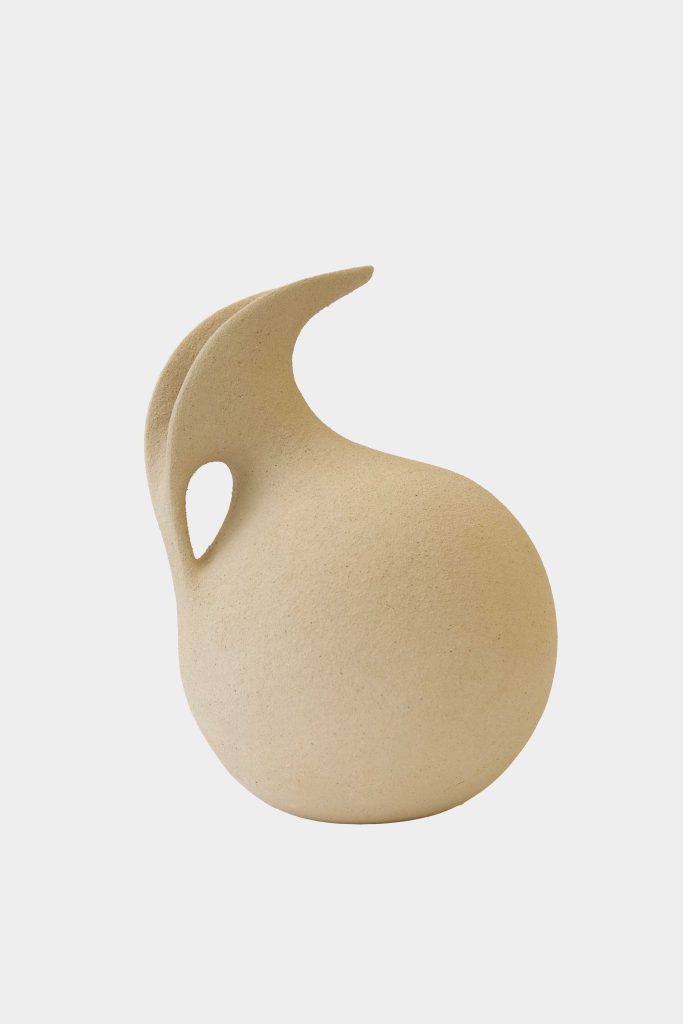




Anyone who has ever worked with ceramics knows this discipline requires a constant balancing act between control and letting go. A prime example in this exhibition is Wendy Taylor’s work. The clear, strictly geometric forms of her vessels echo the aesthetic of mid-century modernism, minimalist geometry, and a familiar lineage of Northern English bricklayers. They serve as both aesthetic statements and tools to retain control. Taylor’s meticulously smooth and right-angled objects are, however, surrendered to the unpredictable forces of the kiln during firing, that moment every ceramicist knows well, when control over the material is relinquished and the fire takes over. Despite the extreme heat and the internal tensions it generates in the clay, Taylor’s pieces maintain their crisp, precise geometry. Normally, such wood-firing conditions would result in deformation – yet Taylor manages to balance the forces so precisely that her vessels remain perfectly upright and composed. Her works thus reveal a compelling contrast between controlled form and wild surface, between precise craftsmanship and fluid process.
In contrast, the works of Babette Wiezorek are governed by algorithms and formulas. Using various architectural and design software tools, she generates the forms of her vessels digitally, continuously adjusting parameters. Her pieces are then realized using a 3D printer that processes a clay-based paste. The resulting objects often resemble coral formations or other organic structures. This interplay between digital calculation and natural inspiration reveals how deeply mathematical principles are embedded in the natural world. Wiezorek’s work explores the fertile tension between mechanical precision and artistic intuition, between virtual design and physical materiality.
The large-scale sculpture by Samantha Albert at first glance appears to be a natural object. Its form and surface evoke a heavy stone more likely encountered in the wilderness than in a gallery. But what initially looks like a natural find turns out, upon closer inspection, to be a highly complex, carefully constructed ceramic object, fired multiple times. Albert’s work engages with geological processes, archaic tool forms, and surface phenomena, resulting in an astonishingly realistic replication of natural material, with the subtle twist that every aspect is entirely human-made. The stone is hollow, a deliberate illusion. And yet it is so masterfully executed that one cannot help but stare in awe. Much of this effect comes from Albert’s expert use of glaze, which mimics the texture and coloration of rose-colored stone with uncanny accuracy.
A different approach to surface emerges in Maximilian Thiel’s practice, which spans both architectural scale and ceramic object. Central to his work is the grafito technique – a method involving the application of multiple layers of plaster or slip, which are then selectively scratched away to reveal the strata beneath. Unlike traditional graffiti, which applies color externally, this process is one of uncovering – a methodical excavation of material history, where the surface becomes a palimpsest of time and gesture. Thiel translates this subtractive method into his ceramic pieces, combining it with glazes and varied firing processes. His use of ash glazes, in particular, brings the alchemical nature of the kiln to the forefront: fire is no longer merely a means to an end but a co-author in the formation of texture and tone. “It’s always about the surface,” Thiel notes – and indeed, his pieces often resemble archaeological relics, objects unearthed rather than created, bearing the marks of both process and memory. A striking example is his ceramic interpretation of a jerrycan – a mundane, industrial object transformed through Thiel’s techniques into something that appears ancient, almost sacred. Its surface, with its patina of ash, texture, and time, recalls bronze artifacts from another era. In this gesture, Thiel collapses the temporal distance between the banal present and the mythic past. His vessels are containers in every sense: of form, of meaning, and of cultural residue. Beyond their conceptual framework, Thiel’s works are technically remarkable. The metallic shimmer and rich chromatic shifts arise from a precise interplay of birch ash, temperature, and time.




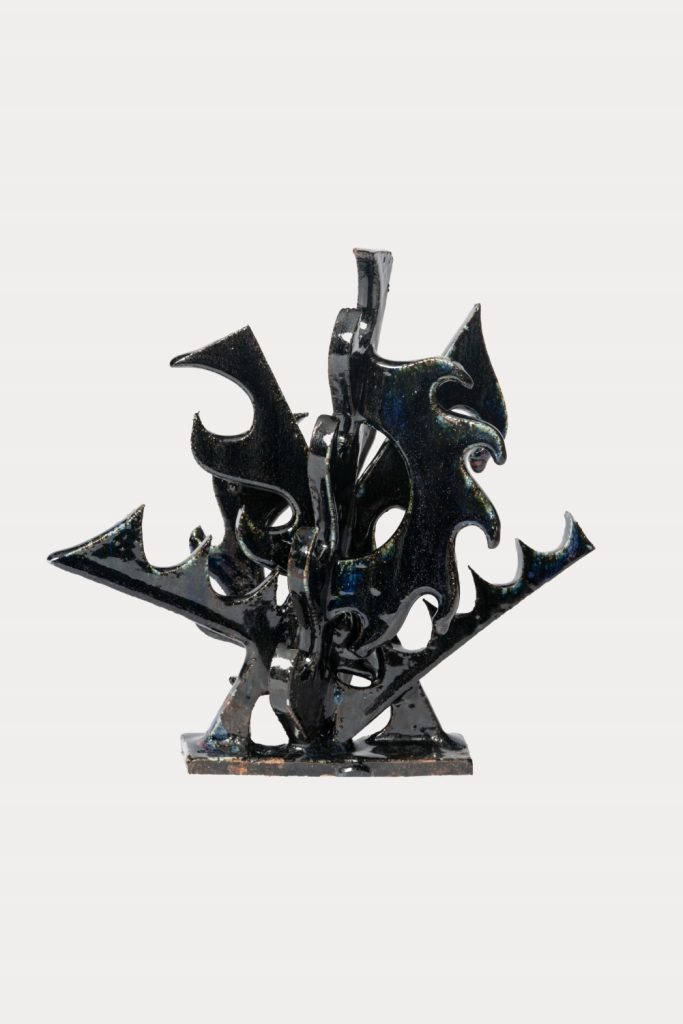

The idea of surface as a narrative space is central to the work of Anton Rahwles. His ceramic pieces are created by pressing found materials – often everyday debris encountered on urban walks – directly into clay. These impressions capture not only the physical texture of discarded objects but also the invisible traces of human presence and movement. The resulting surfaces act like urban fossils: accidental compositions that preserve fleeting encounters with the world. Rather than designing forms from scratch, Rahwles allows the world to leave its mark – his practice is a form of attentive collecting, where spontaneity and chance shape the final outcome. The surface, in his work, is less about aesthetic control and more about testimony: each dent, pattern, and fragment tells a story of origin, use, and neglect. In this way, his pieces become objects of memory as much as material experimentation.
Nikolas Ilturralde, in contrast, embraces form and repetition with ritual-like precision. His objects are meticulously constructed, their graphic patterns repeated across the surface in almost meditative sequences. His works blend Pre-Columbian iconography with Latin American pop culture and Berlin subculture, channeling themes of identity, memory, and transformation – not through direct symbols or imagery, but through structure, rhythm, and color. Trained as a graphic designer, Ilturralde explores the intersection of ornament, typography, and form through techniques like screen printing, calligraphy, and sculpture. The vibrant, often glossy glazes lend his works an almost “sugar-coated” appearance, polished on the surface but laden with deeper resonance beneath.
In addition to the artists already discussed, the exhibition featured a diverse range of other practices that explored the vast possibilities of ceramics, a space where surface becomes a site of storytelling, experimentation, and meaning-making. Formed compellingly demonstrated that Berlin’s ceramic scene is far from static; it is a living dialogue that embraces contradictions, process, and materiality in equal measure, and continues to evolve. By showcasing such a rich variety of approaches within a singular space, Formed underscored the power of collective visibility, inviting audiences to engage with ceramics not merely as craft but as a vibrant contemporary art practice. The exhibition leaves us with the promise of continued growth, dialogue, and discovery within Berlin’s thriving ceramic scene.
Katherina Perlongo (b. 1989 in Bolzano, Italy, lives in Berlin) is Curator at the KINDL – Centre for Contemporary Art in Berlin and co-founder of the curatorial collective CUCO – curatorial concepts berlin. Most recently, she was Director ad Interim and Curator of Outreach at Georg Kolbe Museum. Currently, she is researching topics at the intersection of contemporary art, craft and design.
Formed by Ceramic Salon was on view from June 5 to 8 at the Former Rossmann, Berlin. Participating artists: Anton Rahlwes, Babette Wiezorek, Bachner Vessels, Cúze, Ella Brew, Hap Ceramics, Helka Ceramics, Ia Kutateladze, Jérémy Bellina, Julia Vermöhlen, Juliana Maurer, Keegan Luttrell, Latika Nehra, Marten Herma Anderson, Maximilian Thiel, Nikolas Iturralde, Noki Ceramics, Samantha Albert, Tanja Neubert, Veronika Janovec, Violaine Toth, Wendy Taylor. The exhibition was curated by Lisa Kosak, Marten Herma Anderson, and Wendy Taylor.
Subscribe to Ceramics Now to read similar articles, essays, reviews and critical reflections on contemporary ceramics. Subscriptions help us feature a wider range of voices, perspectives, and expertise in the ceramics community.
Installation views by GRAYSC, courtesy of Ceramic Salon




